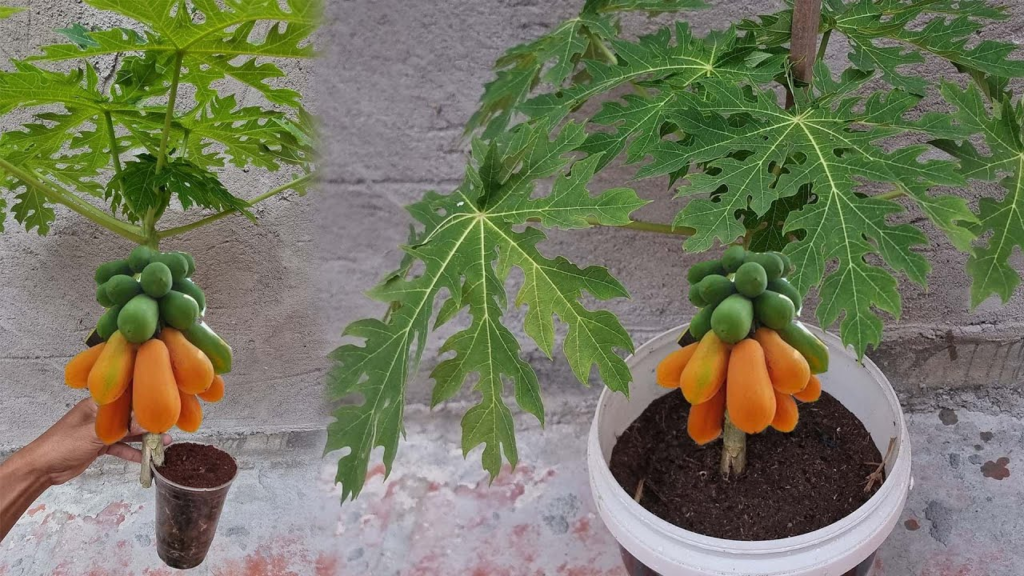Papaya, known for its sweet taste and nutritional benefits, is a beloved tropical fruit. While it’s often linked with warm, sunny climates, you’ll be happy to learn that you can grow it successfully at home, even in cooler regions, by using pots. This guide reveals the step-by-step process to cultivate a thriving papaya plant, so you can enjoy fresh, homegrown fruit right from your backyard or patio.
1. Selecting the Perfect Papaya Seeds
The foundation of a healthy papaya plant begins with high-quality seeds. Here’s how to source and prepare them for planting:
- Choose a Ripe Papaya: Look for a fully ripe, unblemished fruit from the market or your local garden.
- Extract the Seeds: Cut the fruit in half and scoop out the seeds. Rinse them thoroughly to remove any fruit pulp.
- Dry the Seeds: Allow the cleaned seeds to air dry for 1-2 days. This step is essential to prevent mold or rot during germination.
2. Germinating Papaya Seeds
Proper germination is key to healthy papaya seedlings. Follow these simple steps to give your seeds a strong start:
- Use the Paper Towel Method: Spread the dried seeds on a damp (not soggy) paper towel, fold it, and place it in a plastic ziplock bag.
- Maintain Warm Conditions: Papaya seeds thrive in warm environments. Keep the bag in a warm location with indirect sunlight, ideally at a temperature of 75-85°F (24-29°C).
- Check for Sprouts: After 1-2 weeks, inspect the bag for seeds that have sprouted small roots. These are ready for planting.
3. Planting Papaya in Pots
Once your seeds have sprouted, it’s time to transfer them to pots. Container gardening allows you to control growing conditions and move your plants as needed.
- Choose the Right Pot: Use a large pot (10-15 gallons) with drainage holes to prevent waterlogging.
- Prepare Nutrient-Rich Soil: Use well-draining potting soil with a pH between 6.0 and 6.5. Mix in organic matter, such as compost, to boost fertility.
- Transplant the Seedlings: Gently place each seedling into the pot, ensuring the top of the root ball is level with the soil surface.
- Provide Space: If growing multiple plants, position them at least 10 feet apart to give them room to mature and grow.
4. Care Tips for a Thriving Papaya Plant

Caring for a papaya plant in a pot requires consistent attention. Here’s how to ensure your plant stays healthy and productive:
- Sunlight: Papaya plants need at least 6 hours of direct sunlight daily.
- Watering: Keep the soil evenly moist but avoid overwatering. Water deeply when the top inch of soil feels dry.
- Fertilization: Papayas are heavy feeders. Use a balanced fertilizer or a fruit-tree-specific fertilizer every 2-4 weeks during the growing season.
- Pruning: Regularly trim away dead or damaged leaves to promote airflow and maintain a healthy structure.
- Pest and Disease Management: Watch for pests like aphids, mealybugs, and fruit flies. Apply organic pesticides or natural deterrents as needed.
- Support the Plant: As the plant grows and bears fruit, provide support to prevent it from toppling over under the weight of its harvest.
5. Harvesting Your Papayas
After 6-9 months, your patience and care will be rewarded with fresh papayas. Here’s how to know when your fruit is ready to pick:
- Check the Color: Papayas are ready to harvest when they turn yellow or orange, depending on the variety.
- Harvest Gently: Twist the fruit gently from the stem; it should detach with ease.
Final Thoughts
Growing papayas at home in pots is a rewarding experience that brings a taste of the tropics to your backyard or balcony. With the right seeds, proper care, and a little patience, you’ll be able to enjoy a steady supply of fresh, delicious papayas. Keep in mind that papaya plants have a short lifespan of 4-6 years, so be ready to start the process again when your plant’s productivity declines. Happy gardening!
